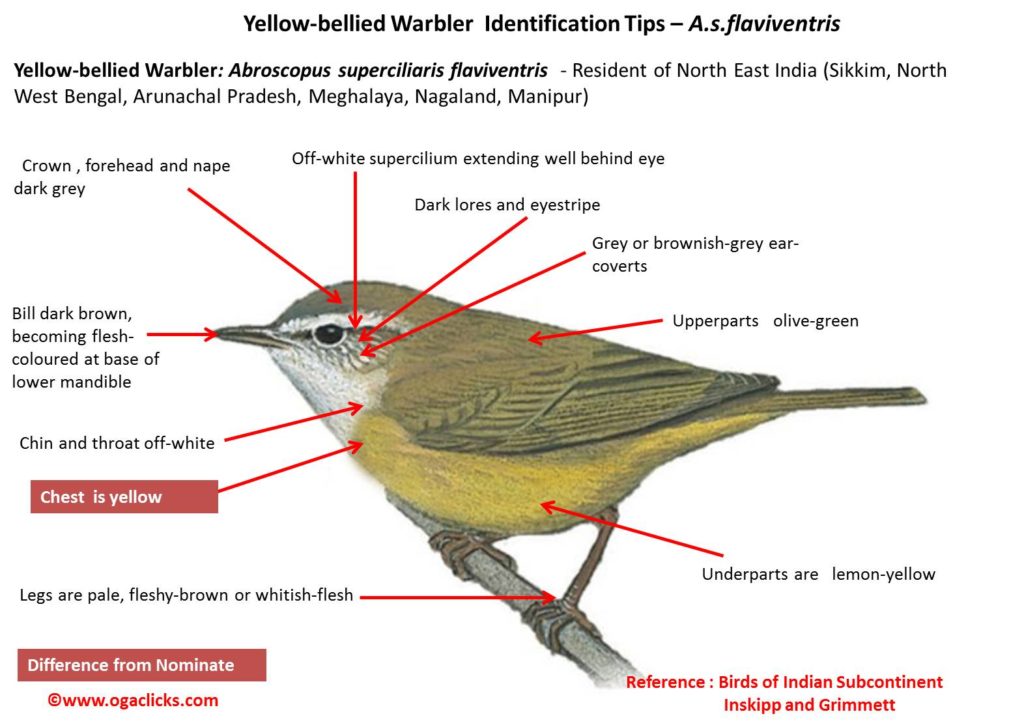Yellow-bellied Warbler

Yellow-bellied Warbler Abroscopus superciliaris
Etymology :
- Abroscopus :Greek word abros – delicate ; skopos – Seeker
- Superciliaris : Latin word for eyebrowed
Vernacular Names : Cachar: Daotisha mini
Distribution in India: Resident of Himalayas, Hills of North East and Western Ghats inIndia.
Description: Size of 9 cm; wt. of 6–7 g. It is a small, rather slim, featureless yellow-and-olive warbler with relatively large bill; short undertail-coverts and narrow tail that combine to give rear end a distinctive appearance. The nominate race has forehead, crown and nape as dark grey, off-white supercilium extending well behind eye, highlighted by dark lores and grey or brownish-grey ear-coverts .The upperparts are olive-green, weak yellowish wash on rump and uppertail-coverts; wings and tail are brownish, feathers broadly edged with olive-green; chin, throat and chest are off-white, remainder of underparts, including underwing-coverts are lemon-yellow; iris is dark brown, inconspicuous thin whitish broken eyering; bill is dark brown, becoming flesh-coloured at base of lower mandible; legs are rather pale, fleshy-brown or whitish-flesh. Both the sexes are similar. The juvenile is duller than adult, with duller darker olive upperparts, lighter yellow underparts. Races differ mainly in colour saturation, especially crown and nape colour and degree of contrast between nape and mantle, extent of white on breast, and intensity of yellowish wash on rump: race flaviventris has nape olive-grey and merging with mantle colour, whitish below confined to chin and throat, with chest as yellow; race drasticus has brownish-grey crown contrasting with olive mantle, strong yellow wash on rump and uppertail-coverts, deep golden-yellow in underparts; race smythiesi has olive-green crown, paler yellow wash on rump, and yellow on underparts shading to whitish on central belly; race euthymus is dark, has almost sooty-grey crown contrasting with dark olive upperparts, quite defined narrow band of yellowish across rump, deep golden-yellow underparts; race bambusarum is almost dark, but has paler grey crown, lemon-yellow on underparts, white of throat extending to chest; race sakaiorum is white of throat extending to breast and belly center. It is found in undergrowth of evergreen forest, especially bamboos by streams in low hills, mountain foothills and adjacent plains; less frequent in secondary scrub. It is found from lowlands up to 2285 m.
Food Habits: It eatstiny invertebrates like tiny spiders, small dipteran flies including mosquitoes and eggs of butterflies. It forages chiefly in understorey, but will freely move into upper canopy and among hanging creepers. It gleans food items from foliage; small insects also taken on the wing during short flycatching sallies. Outside breeding season it forms small parties; sometimes accompanies mixed-species flocks.
Breeding Habits: They Breed in Apr to Jun in NE India and Mar in N Borneo. The nest is constructed by both sexes. The nest is a compact cup of moss, fibers and rootlets placed upon small foundation of bamboo leaves, located above ground and usually in hollow among mass of bamboo stems, or in split or broken bamboo, close to stream. They lay a clutch of 2–5 eggs. The incubation is done by both sexes. The nest is parasitized by Common Cuckoo.